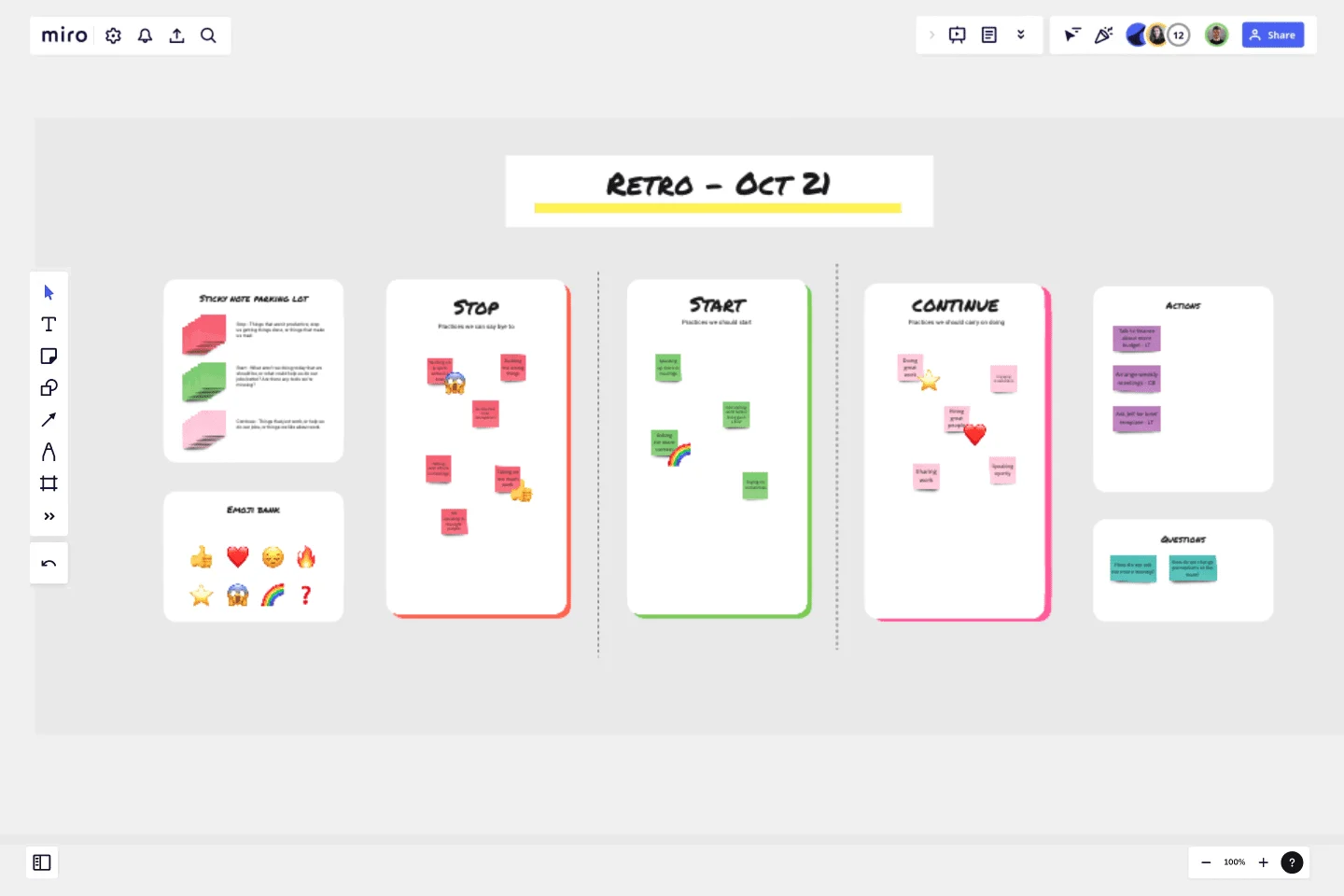Start, Stop, Continue Retrospective by Laura Timmins
A perfect remote retrospective template to get teams thinking about what in their current workflow works well, what needs work, and what do they need to start doing.
This doesn't need to be used at the end of a sprint or project - it can be used when forming teams to determine the best way to proceed successfully. If you haven't run a retro before, there are instructions and recommended timings for each part of the activity, and an idea of what you should be ending up with once the retro is over.
Participants: 2 - 10+ (one facilitator needed).
Time to complete: 15 - 90 mins dependant on team size.
Steps:
Try and use an icebreaker before to get everyone warmed up and ready to share
Ask everyone to spend 5-15 minutes writing sticky notes with items for each of the Stop, Start, Continue areas.
Once this has been done, spend a few minutes grouping these into themes for discussion.
If there is a lot of themes, tell the participants they have between 3 and 5 votes each. They then can vote to decide which topics should be discussed further.
Spend a few minutes discussing each topic, and try to write down actions for each to take away and address.
Tips:
Try to encourage the team to be open and honest.
Ask members to use emojis to react or emphasise different topics raised.
Ensure actions are assigned to individuals to take away to address changes needed.
This template was created by Laura Timmins.
Get started with this template right now.
Quick Retrospective by Online Department
Works best for:
Retrospectives, Agile Methodology
The Quick Retrospective template offers a concise and efficient framework for teams to reflect on recent iterations or projects. It provides elements for sharing successes, challenges, and action items in a streamlined format. This template enables teams to conduct retrospectives quickly and effectively, even with limited time. By promoting efficiency and focus, the Quick Retrospective empowers teams to drive meaningful improvements and maintain momentum in their work effectively.
Product Reflection
Works best for:
Product Management, Planning
The Product Reflection template encourages teams to reflect on past experiences and lessons learned in product development journeys. By facilitating retrospective sessions, capturing insights, and identifying improvement opportunities, this template fosters a culture of continuous learning and improvement. With sections for evaluating successes, challenges, and areas for growth, it enables teams to iterate on their processes and enhance future product development efforts. This template serves as a tool for fostering team collaboration and driving iterative product innovation.
SIPOC by Dagmar Vlahos
Works best for:
Agile Methodology
The SIPOC template by Dagmar Vlahos provides a structured framework for documenting the high-level process flow of a system or project. It helps teams identify Suppliers, Inputs, Processes, Outputs, and Customers, facilitating a holistic understanding of the value stream. By visualizing key process elements and interdependencies, this template enables teams to identify areas for improvement and optimize workflow efficiency, empowering organizations to deliver value more effectively and satisfy customer needs.
Lean Coffee Template
Works best for:
Agile Methodology, Product Management, Meetings
What makes a great meeting (other than donuts)? It’s appreciating everyone’s skills, resources, and time by making the very best use of them. That’s what the Lean Coffee approach is designed to do. Great for team brainstorms and retrospectives, Lean Coffee breaks the meeting into three basic stages: what to discuss, what’s being discussed, and what’s been discussed. This template makes it easy for you to collect sticky notes and to update the columns as you go from topic to topic.
Team´s High Performance Tree
Works best for:
Agile, Meetings, Workshops
The Team's High Performance Tree is a visual representation of the factors influencing team performance. It provides a structured framework for identifying strengths, weaknesses, and areas for improvement. By visualizing factors such as communication, collaboration, and leadership, this template enables teams to assess their performance and develop strategies for enhancement, empowering them to achieve peak performance and deliver exceptional results.
Design Research Template
Works best for:
UX Design, Design Thinking, Desk Research
A design research map is a grid framework showing the relationship between two key intersections in research methodologies: mindset and approach. Design research maps encourage your team or clients to develop new business strategies using generative design thinking. Originally designed by academic Liz Sanders, the framework is meant to resolve confusion or overlap between research and design methods. Whether your team is in problem-solving or problem space definition mode, using a research design template can help you consider the collective value of many unrelated practices.
